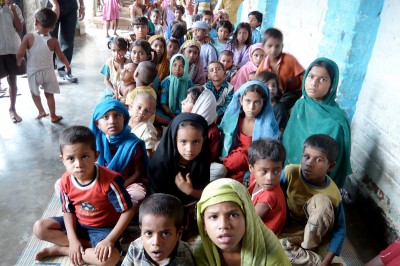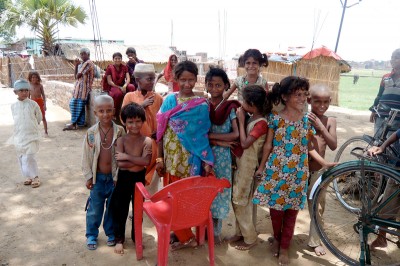On a 2011 reporting trip to visit schools in Bihar, India’s poorest state, one scene in particular stuck in my mind. After a touring a slum neighborhood on the outskirts of the state’s capital city, Patna, my contact there, Sunita Singh, of the Education Development Center, drove me past a small one-room schoolhouse that served the children who lived crammed in the huts and shabby apartment buildings lining a nearby railway. It was a rickety structure with a dirt floor and thatched roof and walls. It looked like it a strong breeze could knock it down.
I had been scheduled to interview the principal at the school and talk to the students there later in the week. But it was the beginning of the monsoon season and it turned out the building was as fragile as it appeared. Before I could return, a torrential rain came through and destroyed the roof. The school was shuttered until it could be fixed.
The news about the nearly two dozen children who were fatally poisoned by contaminated school lunches in Bihar on July 16 was an even more extreme and horrifying example of the monumental obstacles India faces as it tries to reform its education system.
The country’s economic and political future largely depends on improving the quality of life and the productivity of kids in places like Bihar. With this in mind, in 2009 the country passed a right to education law, which, for the first time, gave children from ages 6 to 14 the right to a “free and compulsory elementary education at a neighborhood school,” meaning a school within a couple of miles of their home. School buildings went up across the country, and the free lunch program became an important incentive for getting impoverished children to show up.
Bihar is one of the main target areas for the reforms. The state is India’s poorest and also one of its most populous. Indian census numbers show Bihar’s population is exploding, with a growth rate of 25 percent. There were 19 million children under the age of 6 in 2011, or 18 percent of the population, and nearly all of them live in rural areas.
In addition to free lunch, girls in rural areas of the state are also given bicycles to further boost the likelihood that they’ll come to school. (The female literacy rate in Bihar was just 46 percent in 2011, according to the Indian census.)
The reforms are making a difference, local officials and education advocates say. In Bihar, “almost 50 percent of students drop out before fifth grade,” said Singh. “But before, they didn’t even enroll.” The 2012 Annual Status of Education Report (ASER), an Indian NGO, found that just 4 percent of the state’s children were out of school. In 2005, it was nearly 14 percent.

Muslim children at a nonprofit school in Bihar, India wait to begin their lessons. (Photo by Sarah Garland)
There is still a long way to go before India reaches the fairly modest goals of the new law, though. As the poisonings and the flimsy school building in Bihar show, the school system is still struggling to ensure basic safety, meaning quality often takes a back seat. ASER found that just 43 percent of rural schools were meeting the law’s requirements for student-pupil ratios—two trained teachers per 60 students. Even when schools have enough teachers, those teachers are routinely absent. In Bihar, the report found that 16 percent of students in the equivalent of third grade couldn’t recognize letters. A third could read their letters, but couldn’t read words. Eleven percent of these students couldn’t recognize the numbers 1 through 9, and a third couldn’t recognize numbers higher than 10.
In addition to its goals for improving elementary and secondary education, India has ambitious plans for its higher education sector. Bihar is experiencing a building boom of new universities and colleges, including plans for a new international university meant to draw students and faculty from around the world.
While I was in Bihar, visiting new state-of-the-art facilities and talking to optimistic administrators, I talked to others who wondered, “Who will go to these schools?” Given the still dire situation in the elementary grades, it remains, two years later, a very good question.
Still, there are lessons to be learned from India’s efforts to improve its education system. The problems of Indian schools can make America’s debates over charter schools and standardized testing seem petty. The growing achievement gaps between the poor and affluent in the U.S. are dwarfed by the even wider divides between wealthy and poor Indians. But although its problems seem overwhelming—endemic corruption, high levels of debilitating poverty and vast numbers of children needing help—India has made huge investments in education and is making significant, if slow, progress toward its goals.
And despite the frustrations and disappointments, there is also a lot of hope. The appetite for education in Bihar is ravenous.
On another day during my visit to Bihar, I visited an education program for Muslim children run by a local nonprofit organization. In the state’s Muslim community, which is both large and “steeped in poverty,” according to a 2004 report by local researchers, girls are often discouraged from attending school. Many stay at home and do piecework to support their families. The nonprofit had set up its programs to provide them more flexibility than the regular public schools do—the girls could come during part of the day and practice their numbers and letters, and spend the rest of the day working.
At one of the nonprofit’s centers, small children sat in circles on the floor hunched over workbooks in Urdu, Hindi and English. They were receiving extra tutoring from college student volunteers while regular classes were out. But among them were two teenagers, Nazia and Tazia Hassan, who had spent their elementary school years making saris.
Their father was poor, they said, and had depended on their contribution to get food on the table. Times had changed, though, and the girls said he had begun to see the value of an education. Tazia, 14, said that her goal was to eventually become a doctor. Nazia, 16, had vaguer plans, but thought she might try college someday. “No one will value you if you’re not educated,” she said in Urdu through a translator. “I want to go as far as possible.”




